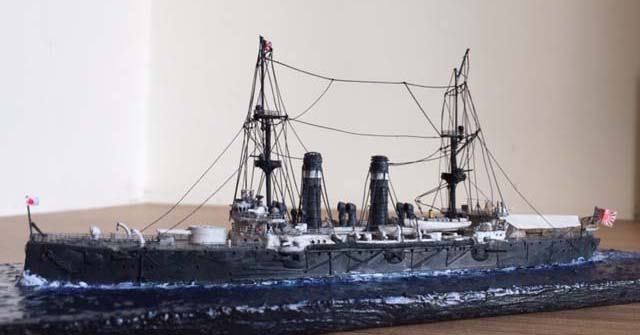
1/700 IJN Asama (Seals Models)
|
by Mark Kendrick |

1/700 IJN Asama (Seals Models)
This is the HMJS Asama, from the Seals Models kit – which can be used for Asama or her sister Tokiwa. HMJS Mikasa aside there are very few plastic kits of warships built in the golden age of British Ironclad shipbuilding prior to HMS Dreadnought. British yards used overseas orders to refine new designs and technologies (often the pre-Jackie Fisher Royal Navy was circumspect of innovation) and equipped most of the Russo-Japanese war Imperial Japanese Navy fleet (Mikasa being the most famous example of course) which gave it a massive qualitative advantage over its’ Russian opponents.Asama was built by Armstrong Whitworth in Newcastle-upon-Tyne launched in 1897, as a protected cruiser, but truly a heavy or even by the standards of the day battle cruiser. She was capable of independent or flotilla operation but also of taking her place with battleships in the battle line. She had a substantial armament of 4 x 8 inch main guns in cutting edge barbeted turrets and 14 Elswick QF 6 inch, and was fast at 21 knots.
One of her first active duties was to represent Japan at the Diamond Jubilee Spithead review, as I have portrayed her here. There is a beautiful colourised photo of her in this livery and rig, including awning, at that event. After the long journey back to home waters (Japan had the luxury of being able to use the Suez Canal unlike the Russian Baltic Fleet) she joined Admiral Togo’s fleet and at commencement of hostilities led the squadron which crippled a Russian squadron at Chemulpo including Varyag. She took her place in the battle line at Tsushima and was heavily engaged, and hit several times with the loss of 11 crew. She had a long autumnal career as a training ship and even survived WW2.
The kit is old but for its’ time is well detailed. It shares sprues with the Seals Mikasa kit which is great for a plethora of spares for other pre-dreadnought projects. There is some scratchbuilding and extensive use of the essential WEM Varyag PE fret. The rigging is stretched sprue, using (very badly - I bow before his genius) the Jim Baumann method. Given the complexity of the rigging anything else would completely prejudice the masts and yards.
